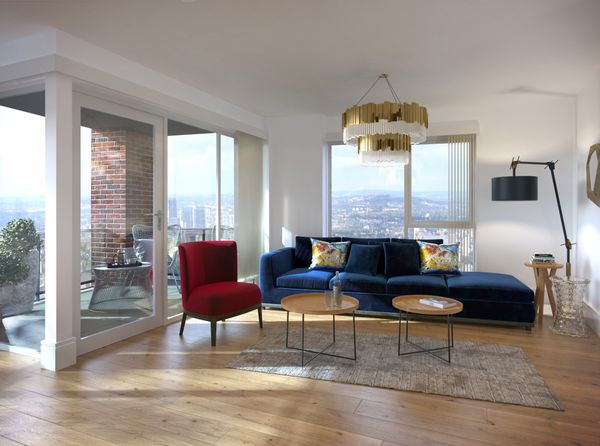Last Updated on: 22nd November 2023, 01:06 am
Over one-third of U.S. workers who are able to work remotely now do so full time. This number is up from 7% in 2019. The COVID-19 pandemic undeniably altered the approach to employment and the ripple effects continue to be felt, perhaps nowhere more so than in the real estate market. With more remote work options, there’s been an exodus from the large office buildings and urban centers that have long been the hub of professional life. Ben Miller, the CEO of alternative-asset manager Fundrise, has taken note, directing a large portion of his real estate funds’ assets away from commercial real estate and into rental housing, particularly in the Sunbelt.
Miller has been investing heavily in cities throughout Sunbelt states such as Texas, Georgia, Tennessee, and Florida.
“Real estate is all about affordability, and those cities are offering the best deals and attracting people freed to live anywhere in the remote-work economy,” Miller told Fortune in 2022.
Currently, Fundrise’s holdings include $3 billion in real estate assets under management, including 8,962 multifamily units and 3,471 single-family homes. The vast majority of these assets are in the Sunbelt.
The company is betting on several macroeconomic trends tied to remote work to drive continued growth in property values and rent costs in the region. Its investments are based on projections of increasing demand for less expensive rental housing and lower costs of living for remote workers, particularly as inflation and rising interest rates put a crunch on home ownership across the U.S.
“If you buy right, inflation drives returns for you,” Miller told Fortune. “We’ll see less home buying and more [lease] renewals. Plus, the people moving into our regions will rent more and buy less. Those factors will keep driving rents higher even if home prices decline.”
Moving to the Sunbelt
For decades, Northeastern cities like Philadelphia, Washington, D.C., New York City, and Boston have been the center of the business world. With this centrality came a hike in the cost of living, including housing. Demand to live near offices in such cities drove this increase and it didn’t show signs of slowing in a significant way until the pandemic hit in 2020. But the subsequent explosion of remote and hybrid job opportunities has left a substantial portion of the working population no longer tied to such high-priced locations.
Accordingly, the data on housing shifts in the U.S. shows a marked increase in demand to move away from larger Northeastern cities and into more affordable Southern areas with milder weather and lower living costs. In other words, there’s been a shift toward the Sunbelt region, which encompasses the southern portion of the U.S. from coast to coast.
A study by real estate broker Redfin found that 26% of U.S. homebuyers searched to move to a different metro area between July and September 2023. All of the top five states homebuyers searched were located in the Sunbelt: Florida, North Carolina, Tennessee, South Carolina, and Texas. Four of the top five areas homebuyers searched to move away from were outside the Sunbelt: New York, Massachusetts, Illinois, and the District of Columbia.
Fundrise’s Investments
Fundrise’s Flagship Real Estate Fund functions similarly to a real estate investment trust. Investors buy into the fund, then own a corresponding portion of its portfolio of real estate investments, receiving a portion of any of its returns. The key difference is that the fund allows investors to buy in with as little as $10. The average investor with Fundrise has staked around $10,000, compared to the six figures often required to invest in a standard private equity fund.
Nonetheless, according to its most recent letter to investors, the fund has weathered the recent downturn in the real estate market better than most standard REITs, and this is due to rental income and increasing property values from the Sunbelt.
“How then has our portfolio managed to perform better than many of these REITs? Primarily because of the types of assets that the portfolio is concentrated in, along with seeing continued actual income growth at the properties themselves,” reads the letter.
“Specifically, the portfolio is almost entirely weighted to residential and industrial properties located in the Sunbelt region, which have proven to be the most resilient asset types within the broader real estate industry and are continuing to see increasing rents. Notably, we also do not have a single high-rise office asset in the entire portfolio, having shunned the asset class for nearly the entirety of the history of the company.”
The company’s Sunbelt assets include build-for-rent homes, as well as multifamily properties.
In 2021, Fundrise secured a $300 million credit facility from Goldman Sachs to finance nearly a half-billion dollars in new single-family home construction in the Sunbelt. This “build-for-rent” approach is a relatively new strategy in real estate investment.
“What we mean by ‘build-for-rent’ is that we build what’s essentially an apartment building as a defined community,” Miller told U.S. News World Report.
“There would be a leasing office and a pool or fitness center, but instead of having it stacked up, you have it laid out horizontally. Those homes could be townhomes or little cottages, or detached single-family houses. It really depends on the geography. Obviously, if you’re in urban infill, it’s going to be super dense, but if you’re in suburban Houston, for example, it’s going to be detached. From an institutional point of view, it operates like multifamily or apartment buildings and from a consumer’s point of view, it lives like [a] single-family.”
The Flagship Real Estate Fund’s current investments include an $84 million acquisition of a 384-unit apartment development near Tampa, Florida, a $16.2 million build-for-rent construction project for 78 single-family homes near Houston’s George Bush Intercontinental Airport, and, most recently, a $34.7 million investment to acquire a 124-home build-for-rent community in Rincon, Georgia.
In July, the fund announced that its $13.1 investment in a horizontal multifamily community near Dallas had paid back successfully, with an annualized yield of 11.5%.
“We view the successful result of this investment as both a validation of this project specifically and of our build-for-rent housing thesis broadly,” said the company in a statement, noting that this is “a thesis in which we continue to anticipate tremendous potential in the coming years.”






